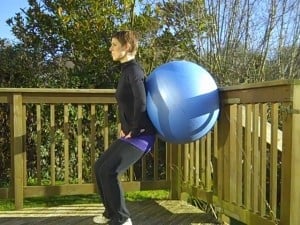Working your core means you need to let your bum curve out. Showing my age here, but from eighties aerobics classes, to ballet, or just being told to ‘stand up straight’, the instruction to ‘tuck your tailbone’ is one we’ve adopted as habit.
“Squeeze your butt” “Suck in your stomach” “Tuck your tailbone under” are all common cues. But they may have the effect of building a fairly flat backside and possible pelvic floor weakness. Not working your core like you intended.

For detail on how to engage your core correctly, read this post.
Working your core right doesn’t mean sucking your stomach in or ‘tucking your tail bone under’ or squeezing your glutes. Try drawing your abs in VERY GENTLY. This really is a very subtle movement, not a forceful one – if you’re not sure, draw it back, then halve that. Imagine a line between your hip bones that you’re going to draw together. You should feel your pelvic floor lift when you do this – that’s good!
Try not to let your pelvis tuck under. Breathe out, slow and steady and draw your belly button in…. but keep that natural curvature in your spine. It’ll feel at first like you’re consciously sticking your backside out.

Different positions to find and work your core

Try it kneeling astride a large cushion or bolster, sitting on the front of a chair or on a large pilates ball. Sit on your sit bones, upright, not on your sacrum with a curved back. Try to very gently engage your deep core muscles, without tilting your pelvis and rolling onto your tailbone. Also try squatting from standing but supporting your back with a ball behind you, as in the picture.
You see there is a difference between ‘finding your core and ‘working your core’. If you haven’t found it, you can’t work it. Our brain forgets how to talk to some muscles in our body after pregnancy and childbirth because they have been unused, in a position not be able to work optimally, or taking up the strain of other imbalances and… your body cannot use a muscle that your brain’s stopped talking to.

Tucking your tailbone… and your pelvic floor
Tucking your pelvis under and/or squeezing your bum muscles, ‘shortens’ the pelvic floor muscles. If you can visualise, your pelvic floor muscles are a hammock of musculature attached at your tailbone at the back and your pelvic bone at the front. So curling your pelvis underneath you shortens and tightens the muscle by bring your sacrum / tailbone closer to your pelvic bone.
This movement has 2 downsides:
- A tight muscle is not a strong muscle – your pelvic floor needs to be supple and strong, able to work in its full range (or length). Pelvic floor exercise should be a synchronized ‘lifting’ effort of all of your deep core muscles working together, not an isolated squeeze, and tucking your tail under keeps it permanently short and tight.
- Your deep abdominal muscles cannot work correctly if your pelvis is tucked under. Similarly, your deep abdominal muscles do not create this movement. So being in the tucked position is doing nothing for your core muscles.

Squeezing and tucking isn’t working your core
Try squatting, and watch yourself side on to that mirror again – your tailbone should head down and back, sure (don’t over arch your back and stick it up)… but not under. Watch yourself and try to maintain that natural curve of your spine as you squat. Aim to have your shins stay vertical, and use support if you feel unstable at all. Holding onto something solid like a stair rail or heavy table (or hold onto someone) with both arms in front of you is an effective support, to be able to focus on form rather than falling over!
There are of course many natural and valid ways to squat, and a full, deep resting squat position or an Olympic lifting squat for example will not necessarily involve vertical shins or an entirely neutral spine. But the above pointers are for you to develop a safe, effective squat that will serve you in an exercising squat, and as you go about picking up things, lifting things and general movement. As your squat, your core and your glutes develop in functionality, response and strength, by all means experiment further!












